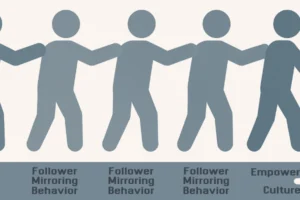Leadership Q and A: Because You Asked
I want to answer some of the leadership questions that have come in and some questions that I’m sure some of you may have. Remember, leadership is a life-long process of learning, and I challenge everyone to question with boldness, even their own conclusions. Enjoy!
Who is really in charge of creating organizational effectiveness?
The creation of organizational effectiveness comes from two sources really. The first source is, of course, the leadership of the organization. The second is the individual worker. Each leader and each worker has a specific function. If that function or the individual is doing a bad job or has a bad direction, the result and overall effectiveness will be hindered. So to further narrow down the answer, leaders must provide the resources necessary for the workers to complete their required tasks effectively, and the worker must perform as expected.
Why is it important to translate your organization’s vision and mission into day-to-day activities?
It is important to translate the vision and mission into day-to-day activities because doing so details goals and objectives and ensures the rest of the change process (Summers, 2009). It also helps to identify breakdowns in regard to communication and follow-through.
Tell me about Controlled and Uncontrolled variations and Common causes vs Special causes.
Controlled variations (common causes) are variations within the process. Uncontrolled variations (special causes) are variations outside of the process. A good example of both would be that of a man going down the road on his bicycle. He is peddling his bike to make his bike go forward, which would be considered a “common cause.” However, if a tornado came by and picked up the bike and threw it down the road, that would be an uncontrolled variation or special cause.
What does it mean to manage by fact and with a knowledge of variation?
Again, controlled variations (common causes) are variations within the process. Uncontrolled variations (special causes) are variations outside of the process. So to manage by fact and with a knowledge of variation, leadership would basically collect data about the work being performed and use that information to make decisions about and affecting work, but do so while considering the variations that have already been identified (Summers, 2009). Simply stated, it is to resist the temptation of believing that a special problem is impacting the system when there is more than likely just a natural variation in the system.
How is quality strategic planning different from traditional strategic planning?
From what I can tell, the biggest differences (though there seem to be several) between quality strategic planning and traditional strategic planning is that quality strategic planning is more defined and based off of process results and actual data. Traditional strategic planning is more about broad ideas and undefined direction and more about shooting from the hip in a particular direction. Metaphorically speaking, traditional strategic planning would be like a Matchlock Musket compared to quality strategic planning, which would resemble more of a precision-guided Hellfire II lightweight anti-tank weapon.
Why does an effective organization need a strategic plan?
An effective organization needs a strategic plan for a couple of reasons. To begin with, a strategic plan will consider the company’s vision and mission (Summers, 2009). This is important because it will act as a sort of road map for the direction in which decisions will be made. This basically allows the organization to formulate the necessary details of each “mission” on the way to the bigger goal.
What are the benefits of a strategic plan?
Strategic planning clearly defines the purpose of the entire organization (NAMAC, 2009). It also improves the use of precious resources, establishes a direction for the organization, increases innovation, and ultimately supports customer satisfaction (Summers, 2009). It also establishes a road map in which to follow in case someone loses their way. Strategic plans can be a reminder or a guide, depending on how things are going. Furthermore, it is owned when it is written and must take more writing and agreements to adjust.
What does an organization need to know about itself before creating a strategic plan? Why is this information important?
This could be answered in a couple of ways, depending on how you want to look at it. On the surface, the organization would want to know its strengths and weaknesses, customer information, economic environment information, competition, government information, and technological environment, etc. This would all be critical information when formulating a strategic plan. However, I feel another list may be more important regarding this answer. Vision, mission, critical success factors, goals, objectives, indicators, and contingency plans. I think this is a better list for several reasons. If done correctly, the second list would undoubtedly encompass the first list. I also like the second list more because its focus is geared toward the ultimate goal, whereas the first list seems more focused on today. If this has taught us anything, it should be that maintaining focus on the long term is critical, and the second list does that. Formulating a strategic plan with the longer term in mind will undoubtedly be a better idea. In order to do that, leadership must fundamentally know what the organization wants and dreams of being and incorporate those ideas into whatever plans they make.
How do effective organizations use performance measures?
The most basic response I can provide for this would be that organizations use performance measures to guide improvement efforts by better understanding the organization’s overall performance (Summers, 2009). It’s about identifying and reviewing measurable results demonstrating progress toward goals and objectives. Those goals and objectives are already identified in the mission, vision, and goals.
What is the difference between a functionally structured organization and a process-focused organization?
A functionally structured organization is what most would think of when it comes to an organization; specific activities are separated out by the department. The process separates out a process-focused organization, where those who work on that process are cross-trained on more than just one specific activity (Summers, 2009).
An example of this might be that of awning production. In a functionally structured company, you would have a welding department, a graphics department, a stitching department, an assembly department, and so on. However, in a process-focused organization, a department would be focused on a specific line, and everyone there might know how to weld, stitch, assemble, and so on.
How would you recognize that a process needed to be improved?
Process mapping, problem isolation, root cause analysis, and problem resolution are the best ways to go (Summers, 2009). However, this does not exactly spell it out because it depends on the specific issue and how it was identified.
For this particular answer, I have to use a scenario. For instance, customers continue to return a particular item because it has a defective plastic widget. Obviously, it would be important to start with this process because it has the greatest and most immediate impact on a competitive advantage or customer requirement.
Then the company would need to investigate the piece, the process, the materials, the assembly, and so on. This could be because the widget is fine, but a particular worker is being too rough during installation. Or perhaps the call to go with plastic over composite material or metal was a bad one.
If it were a time of assembly issue, we would examine the process of assembly. I guess to best answer this question would be to say that it would depend greatly on whether or not the problem was already identified or are we were seeking a problem to identify.
Why is process mapping an important tool for improving the process?
Process maps visually demonstrate the process or operation as it currently is. It can also be a tool to help identify or project possible changes down the road with additions or subtractions in the process itself (Summers, 2009). This will help leadership clarify whether a particular move is a good one or a bad one.
By the way, you might also like my article titled, “Perception of Leadership.”
References
NAMAC. (2009, January 1). What are the benefits of strategic planning? Retrieved from http://www.namac.org/strategic-planning-benefits
Summers, D. C. S. (2009). Quality management: Creating and sustaining organizational effectiveness. Upper Saddle River, N.J: Pearson/Prentice Hall.




